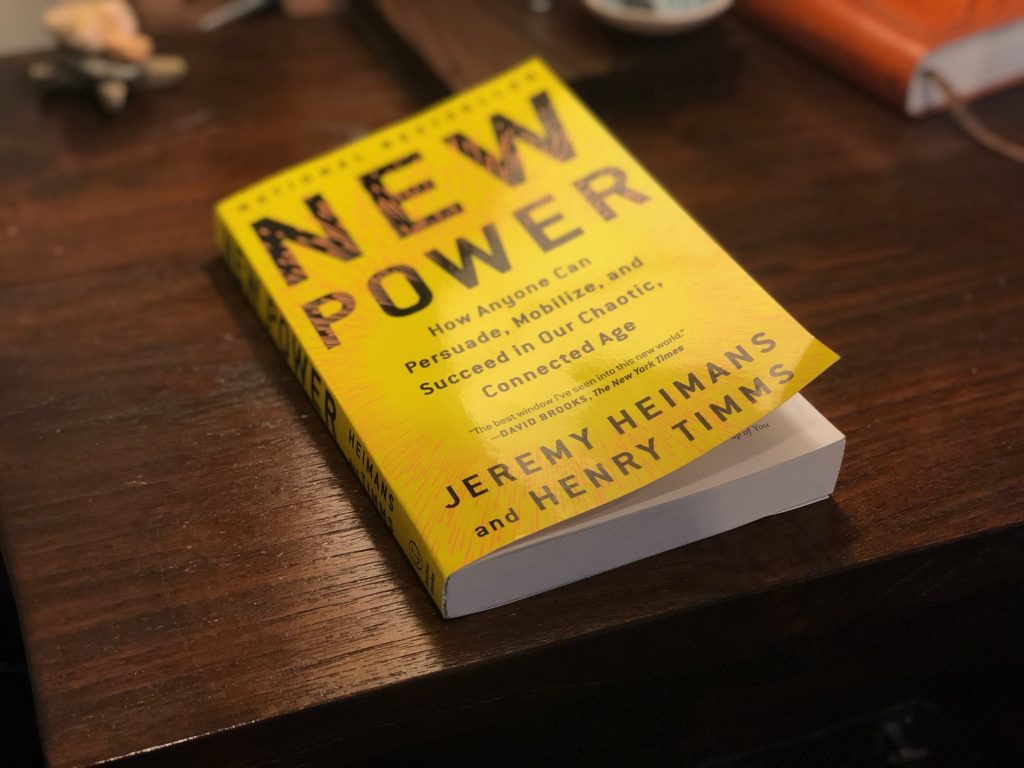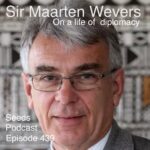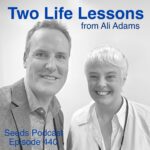Review of “New Power: How anyone can persuade, mobilize, and succeed in our chaotic connected age.” By Jeremy Heimans and Henry Timms
Having just been involved on 24 April 2020 in facilitating a Virtual Impact Unconference for 350+ I was interested to read this book. How would what we did fit within the framework of what they talk about? Essentially the authors propose that there are “Old Power” ways of doing things. Those involve formal structures with centralised power and strict rules. These contrast with the “New Power” of the title which are movements which emphasise collaboration, transparency and also – perhaps most important – ask for participation from many. This often turns to “the crowd” and decentralised ways of pulling together ideas. Forbes magazine in its review of the book noted that “phenomena transforming society today is fueled by the ability to activate large numbers of people to participate in a collective conversation”. It is that which this book tries to explain.
Perhaps it is easiest to outline what is said about “New Power” by providing some real life examples: These include movements like Black Lives Matter, Wikipedia, Facebook and new models of business that outsources to the crowd like Airbnb and Uber and also I think crowdfunding platforms like PledgeMe in New Zealand. There are the dark side of these sorts of movements as well such as ISIS. One clear example of the contrast of old vs new is the difference between Harvey Weinstein (representing old power) and the #metoo movement (representing new power).
A few other examples of key words that the authors cite to show the differences: The contrast is “Power held by few” vs “Made by Many”, “Download” vs “Upload”, “Leader-driven” vs “Peer-driven” and “Closed” vs “Open”. In a Harvard Business Review article, which must have preceded writing the book back in 2014, the authors noted that Bertrand Russell said that power is defined as “the ability to produce intended effects”. In the same article they note that “New power models are enabled by peer coordination and the agency of the crowd – without participation, they are just empty vessels. Old power is enabled by what people or organisations own, know or control that nobody else does – once old power models lost that, they lose their advantage.”
In thinking about how to summarise what they mean when they talk about the old and new ways of leveraging power, it’s about a surge of collective awareness and action and support. New power calls on participation and involvement not just consumption. I kind of think of new power being like a river rushing through with a flash flood rather than the old power of a settled lake. The book makes the point that these movements are often peer driven and participatory and involve many.
When it comes to some other examples of the contrasts, they note the following – where does your organisation fall?:
- Salesmanship vs universally accessible storytelling
- Proven credentials and technical expertise vs compelling personal or group narrative
- Developing elite patronage relationships vs mobilze crowd and key social influencers
- Navigate complex bureaucratic systems vs navigate complex community systems
- Create a luxury or exclusivity premium vs create a participation premium
In my experience in working on facilitating of the Impact Unconference this book echoed a lot of what I found and what we had sort of naturally adopted. Just as a few examples, we had a flat structure for organising the event and it was definitely crowdsourced in terms of the organisers, who were all volunteers, and who formed the great team behind the scenes doing the work. We appealed to a greater cause – something bigger than doing this for financial gain and so became a movement because we wanted to use technology to give a platform for people to share their ideas by crowdsourcing the content – and we had 35 ideas submitted for 20 slots. We had 337 people buy tickets and a wait list of around 60 others. If we had actually done paid advertising it would have had event greater uptake – amazing since this was a first ever event for Aotearoa. We had no marketing budget for the event and simply relied on people spreading it among their online networks. I had actually thought we would need a few “key notes” to draw in crowds and had even arranged some great people to be involved. In a way that shows we were relying still on an older style of conference organising, that you need to have those names to draw people, rather than relying purely on your crowd to help promote it. The ironic thing is we never actually used the drawcard names to bring more along because the organic sharing and exposure was more than enough. So I think the Impact Unconference was actually a great example of utilising “New Power”.
I also think that Seeds podcast is an example of all this because it really relies on people like you helping to spread the word about it – my crowd – so it is nice to think about it in these sorts of terms.
This short review cannot hope to cover all the details – for example they go into the contrast between different types of new and old powers and those which blend these concepts as well. Part of the challenge is for organizations to become bilingual, and understand how the dynamics of both styles of power work.
The key takeaway is the idea that if we are involved in some movement or organisation then it helps to understand how the new power system works. The book also gives some ideas about how to build movements and connect with people around a cause or a brand or movement. There is even a chapter called “How to build a crowd”. Ideas there include finding your connected connectors, building a brand image that inspires participation, lower the barrier to participate and encourage people to move up the participation scale (from the lower end like consuming to actually producing).
One of the key stories they mention is the “Ice Bucket Challenge” which became an internet sensation a few years ago. It raised money for a worthy cause and had lots of celebrities and normal people pouring ice water over their heads. They identify three key parts of this which I thought were interesting when it comes to making an appeal to the public:
- Actionable: The idea is designed to make you do something, so there is a strong call to action at its heart. In this case, pouring ice water over your head, donating and nominating others to join in as well for a good cause.
- Connected: The idea promotes being connected with others who feel the same as you and you share values with. It brings you closer to a likeminded community that others want to join (by participating and in turn sharing). In this case, celebrities got involved as well so you were part of something bigger – you were in the story.
- Adaptable: The idea can be easily adapted or customized or restructured and encourages others to alter and use it in their contexts. In this case, people did variations such as Patrick Stewart putting two cubes of ice in a cup with whisky and drank it – while also donating. [Note: they use the word extensible so that it becomes ‘ACE’ but I think adaptable is what they are really intending]
So to finish off this review, I find this type of book helpful because it adds structure to thinking I’ve been doing around what is changing in the world – but which I had not articulated in this way. It reminded me of another book I reviewed recently here, ‘Dare to Lead’ by Brene Brown. I would recommend taking a look at this book. There are some good challenges about how to set the foundation for a movement and practical steps and learnings from others to implement to ensure there is good exposure. It is also helpful to think in the terms they propose of New Power and Old Power and look through the world – and your own organisation or things you are involved with – through those lenses.





